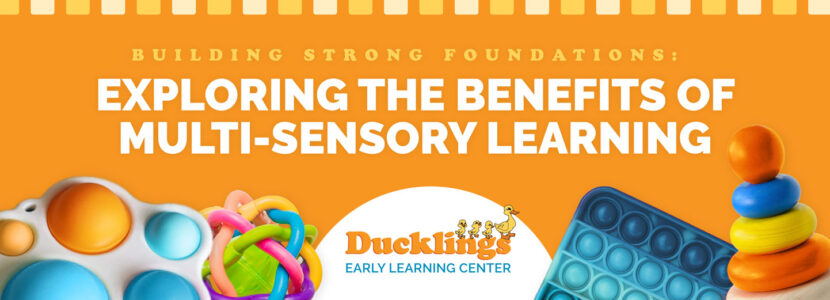We are all exposed to new information and new experiences multiple times a day, just like children. Being able to absorb and process all this information is an important part of childhood development, as they are learning from everything around them all the time.
Every child is different with different learning styles, which is why multi-sensory learning is an effective and inclusive way to reach every child. When looking for a childcare center it’s important to ask what learning styles they practice. This way you will have a comprehensive idea of the type of childhood education your young one will receive.
There are many different benefits to multi-sensory learning, and all five senses play a major role.
Multi-sensory activities increase strengths and improve weaknesses
Daycare centers typically have different rooms based on the age ranges of children. Considering each individual child is something that educators must make note of. It’s important that if it’s discovered that a child doesn’t respond to and recall information in the traditional ways, it is necessary to consider how the brain receives information.
At Ducklings Early Learning Centers, all classrooms incorporate multi-sensory activities. Multisensory activities benefit all students and are implemented daily in our classrooms. However, the key is to use more than one sense at a time in order to cement the concept. When a lesson uses multiple senses at once, it reinforces students’ strengths and strengthens their weaknesses.
Sight: Students see stimuli with their eyes. Around the classroom there might be sight words labeling a chair and a table. Some students might use flash cards, or create a word wall. A shelf full of books is also a fantastic way to engage students visually even if they can not recognize words. Pictures tell quite a story!
Hearing: Students hear stimuli with their ears. This can include hearing letters and letter sounds as you say them, singing rhyming songs, and participating in read-alouds. A great way that we engage both sight and sounds in our ducklings classroom is reading big books out loud and pointing at the words. That engages the senses and encourages participation.
Touch: Students touch stimuli with their hands. A hands-on approach is crucial for young learners and is an element that any daycare should remember. Tracing letters with their fingers while saying the letter out loud or manipulating kinetic sand into letters while saying them out loud are exercises that our little ducklings enjoy.
Smell: Students smell stimuli with their noses. While smell may not seem like an easy thing to incorporate in a classroom, there are a few fun ways the kids love! Scented markers are always a bit hit, especially when we ask them to draw what the marker smells like. Scratch-and-sniff books and smelly stickers are also easy ways to bring scent into our multi-sensory learning.
Taste: Students taste stimuli with their mouths. Snack time is a great opportunity to throw some learning into the mix. Sorting Cheerios or Goldfish crackers into groups of two, or using pretzel sticks to form letters are tasty ways to engage young learners. And of course, the thrilling part is they get to eat their creations.
The best part about multisensory activities is that they usually feel like play to children. Multisensory activities provide necessary intervention for the students who need it, while making learning more fun for all of our students. When you search “child care near me” be sure to check that they incorporate multi-sensory learning. At Ducklings Early Learning Center, all of our teachers and staff are committed to caring for the whole child throughout their rich childhood development.

